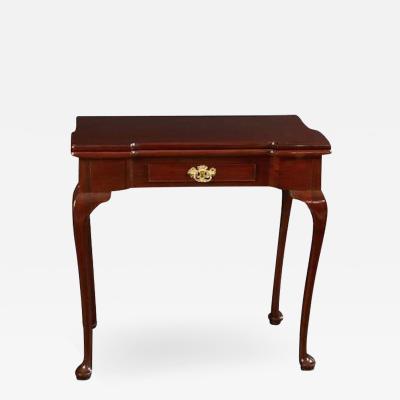American Windsors In the Dietrich American Foundation
 |
By Christopher Storb
Over his lifetime, H. Richard Dietrich Jr (1938–2007) assembled an extensive and diverse collection of American art and artifacts. Dietrich began to collect in earnest after he established a nonprofit institution—The Dietrich American Foundation—in 1963. Books and manuscripts were his first focus, but his collecting expanded to include American furniture, Pennsylvania German fraktur, silver, Chinese export porcelain, whale-trade objects, and paintings.
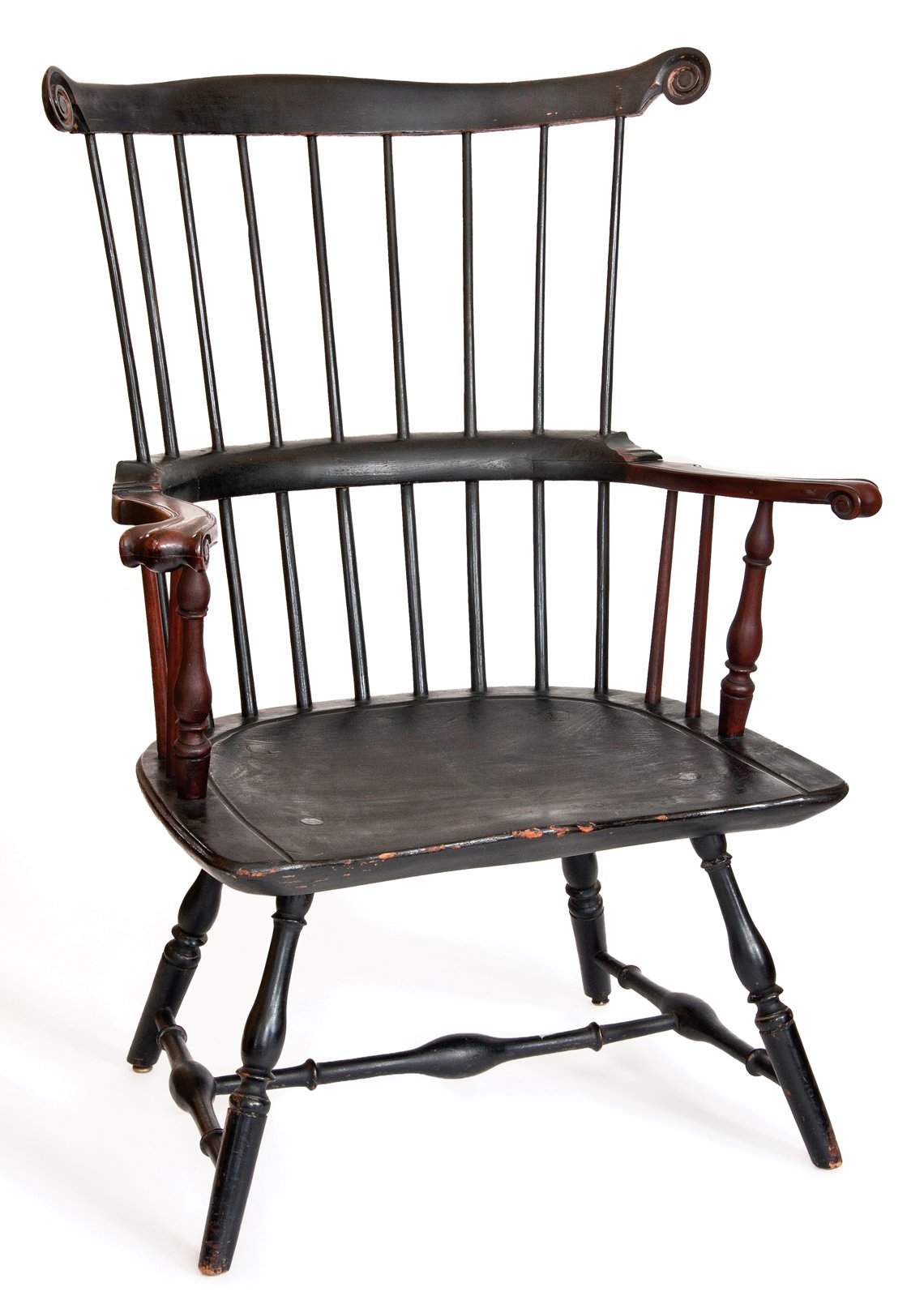 | |
Fig. 1: High-back Windsor armchair, Philadelphia, Penn., 1765–1775. Yellow poplar, maple, hickory, mahogany. H. 43¾, W. 32¼, D. 26 in. Monumental in size, this chair may have functioned in a ceremonial role. In addition to the medial stretcher, the side stretchers also have collared rings to reduce their visual length. Photo by author. |
In 1966, Dietrich purchased Arkadia, in Chester Springs, Pennsylvania, an early eighteenth-century stone house with later additions, which would be his primary residence for the rest of his life. That year, Dietrich purchased his first examples of American Windsor seating furniture—a Philadelphia high-back armchair (Fig. 1), a Lancaster County, Pennsylvania, low-back settee (Fig. 2), and a New York continuous-bow child’s armchair (Fig. 3). Through the following twenty-two years, Dietrich created a small but carefully chosen and notable grouping of American Windsor furniture, creating a significant subset of objects in the Foundation’s American furniture collection. He admired their complexities of construction, sculptural form, and the fact that the first Windsor chairs made in America were produced in nearby Philadelphia.1 While all the Windsor seating furniture Dietrich collected was ultimately bequeathed to the Foundation at the time of his death, for many years they would remain in his personal collection and part of the furnishings of Arkadia.
What led Dietrich to aspire to add Windsor chairs early on in his pursuit of Americana is uncertain, though he would have known they had long been recognized as a category collectors of Americana might choose to pursue. Wallace Nutting’s Furniture Treasury2 has no less than ten pages illustrating Windsor settees and a remarkable fifty-eight pages of full-size and child’s-size Windsor chairs. Chapter X in William Macpherson Hornor, Jr’s Blue Book of Philadelphia Furniture3 is titled “Windsor and Rush-Bottom Chairs.” Hornor described Windsors as “characteristic types of Philadelphia furniture.” The sale of the collection of the J. Stogdell Stokes (1870–1947) at Parke-Bernet Galleries in 1948 included numerous American Windsor chairs, many formerly in Nutting’s collection. Stokes was a Philadelphian who was president of the Philadelphia Museum of Art from 1937 until his death and had written one of the earliest articles on Windsor chairs in which he asserted “Philadelphia was the birthplace of the American Windsor chair.” 4
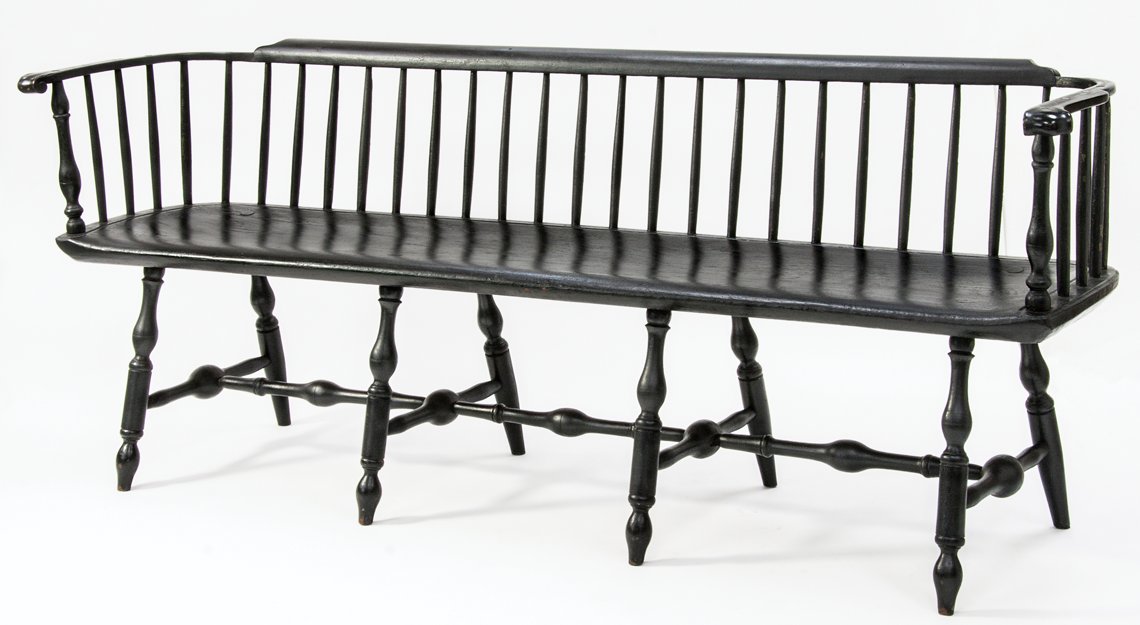 |
Fig. 2: Low-back Windsor settee, Lancaster County, Penn., 1780–1800. Yellow poplar, maple, hickory. H. 30½, W. 77½, D. 21 in. The original green paint survives under a later darkened over-varnish. Photo by author. |
Early in his collecting career Dietrich relied on advice from Elinor and Horace W. Gordon of Villanova. Meeting the Gordons after attending a lecture given by Elinor on Chinese export porcelain in 1963 led to a friendship that helped shape and define Dietrich’s growing interest in local decorative arts. With the assistance of the Gordons, Dietrich’s Windsor collection began with the purchase of two chairs and a settee in 1966. Horace encouraged Dietrich’s acquisition of a high-back armchair which had been advertised by Millbrook, New York, dealer Charles Woolsey Lyon (fig. 1).5 Both Dietrich and the Gordons would have taken note of the monumental scale and rare feature of mahogany arms, arm supports, and short spindles of Lyon’s high-back armchair. That it held the possibility of a provenance that could be researched would also have been enticing to Dietrich. “R. R. Wurts” is written on an old paper tag attached to the bottom of the seat. According to Lyon, the chair was “acquired from a direct descendent of Robert Kennedy Wurts, Esq., who inherited it from his ancestor, one of the foremost original Swedish families to settle in the lower Delaware River area.”
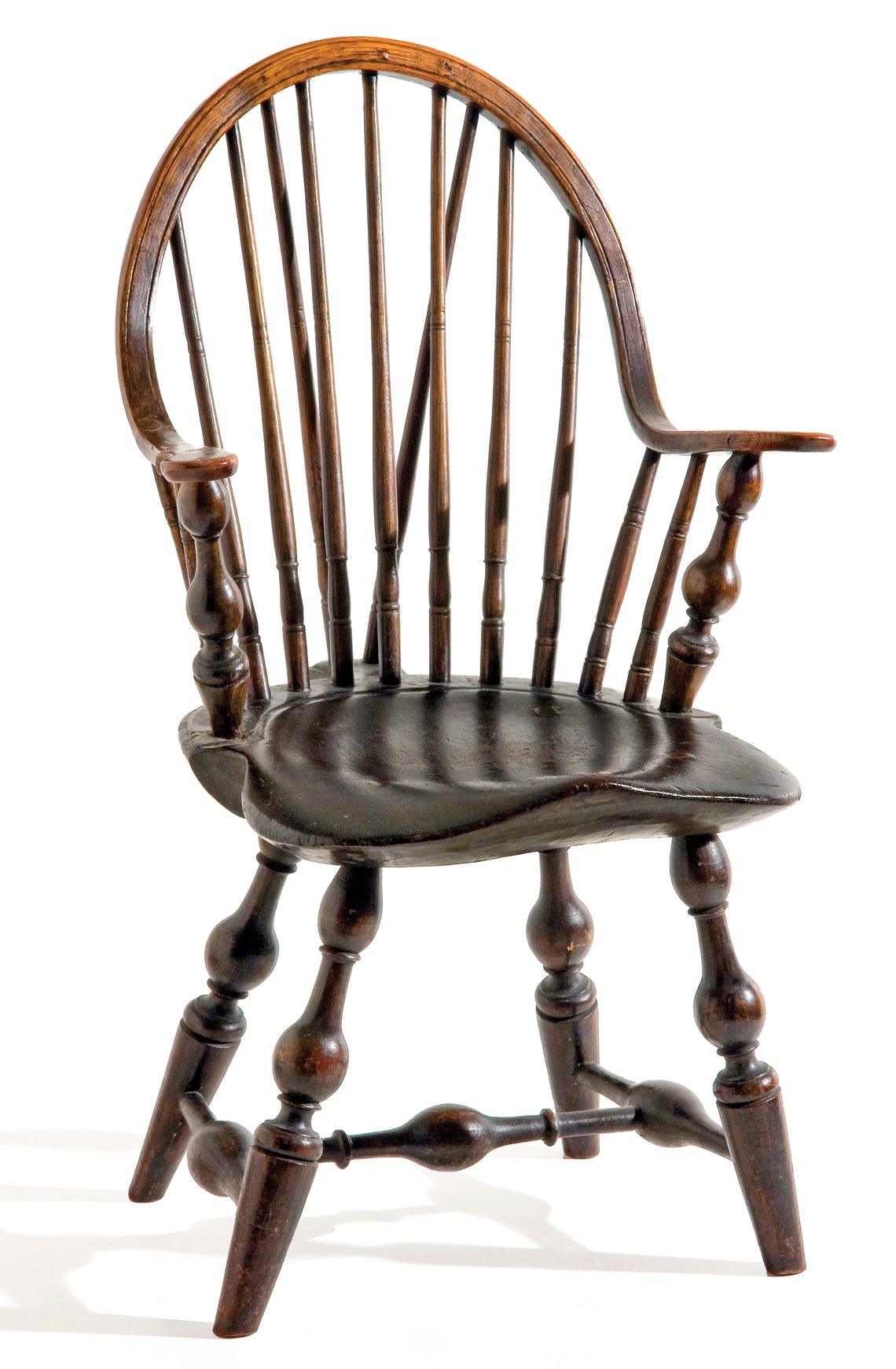 | 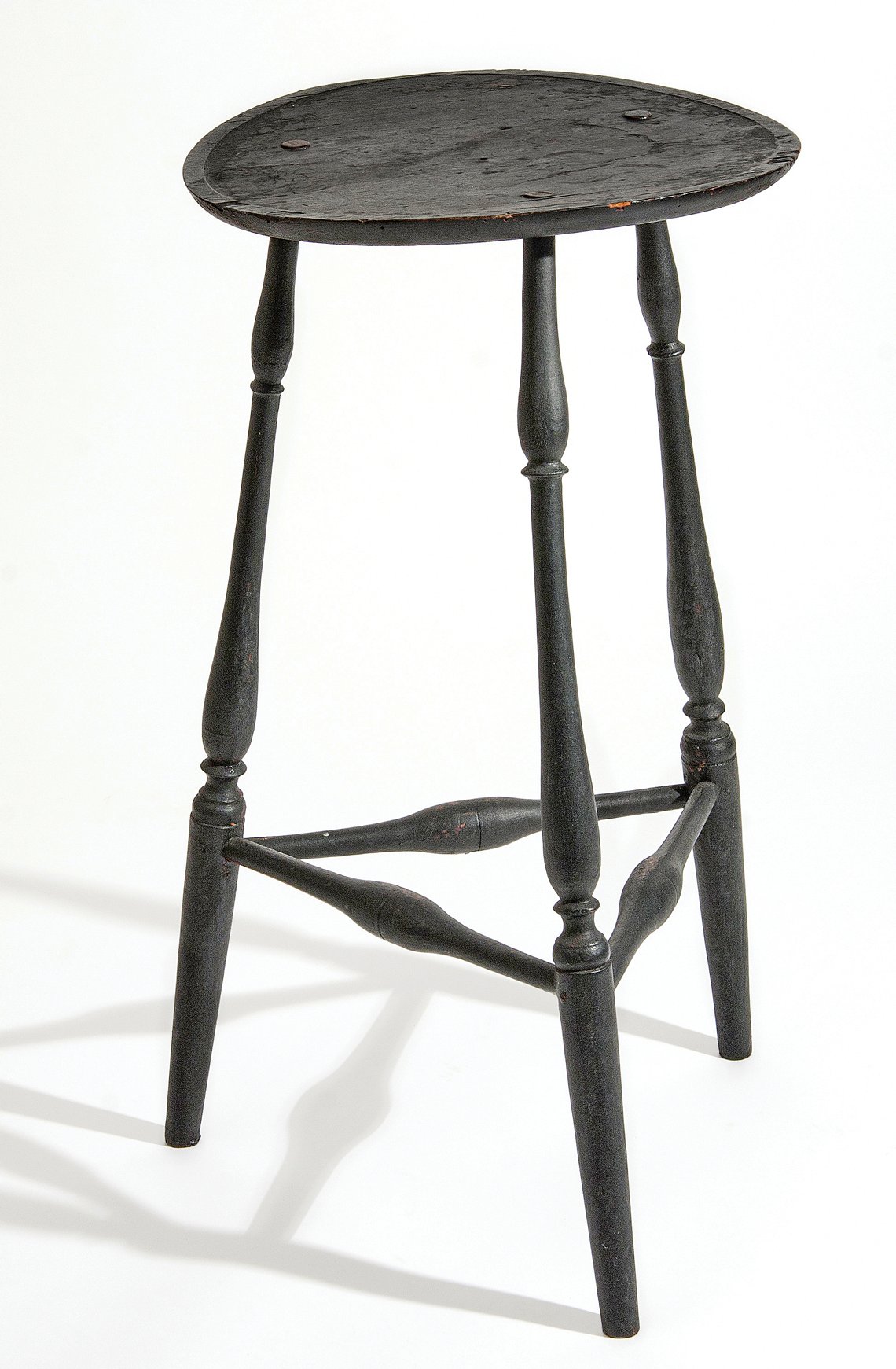 | |
Left, Fig. 3: Childs continuous-bow Windsor armchair, New York City, New York, 1785–1794. Yellow poplar, maple, hickory, oak. H. 25, W. 15, D. 14¾ in. Several adult Windsors labeled by the New York City chairmakers Thomas and William Ash have related spindle ornamentation. Photo by author. Right, Fig. 4: Windsor stand, Southeastern Pennsylvania, possibly Philadelphia, 1770–1800. Maple, conifer. H. 26½, W. 15¼ in. The legs are mortised through the turned and dished top and wedged. Photo by author. | ||
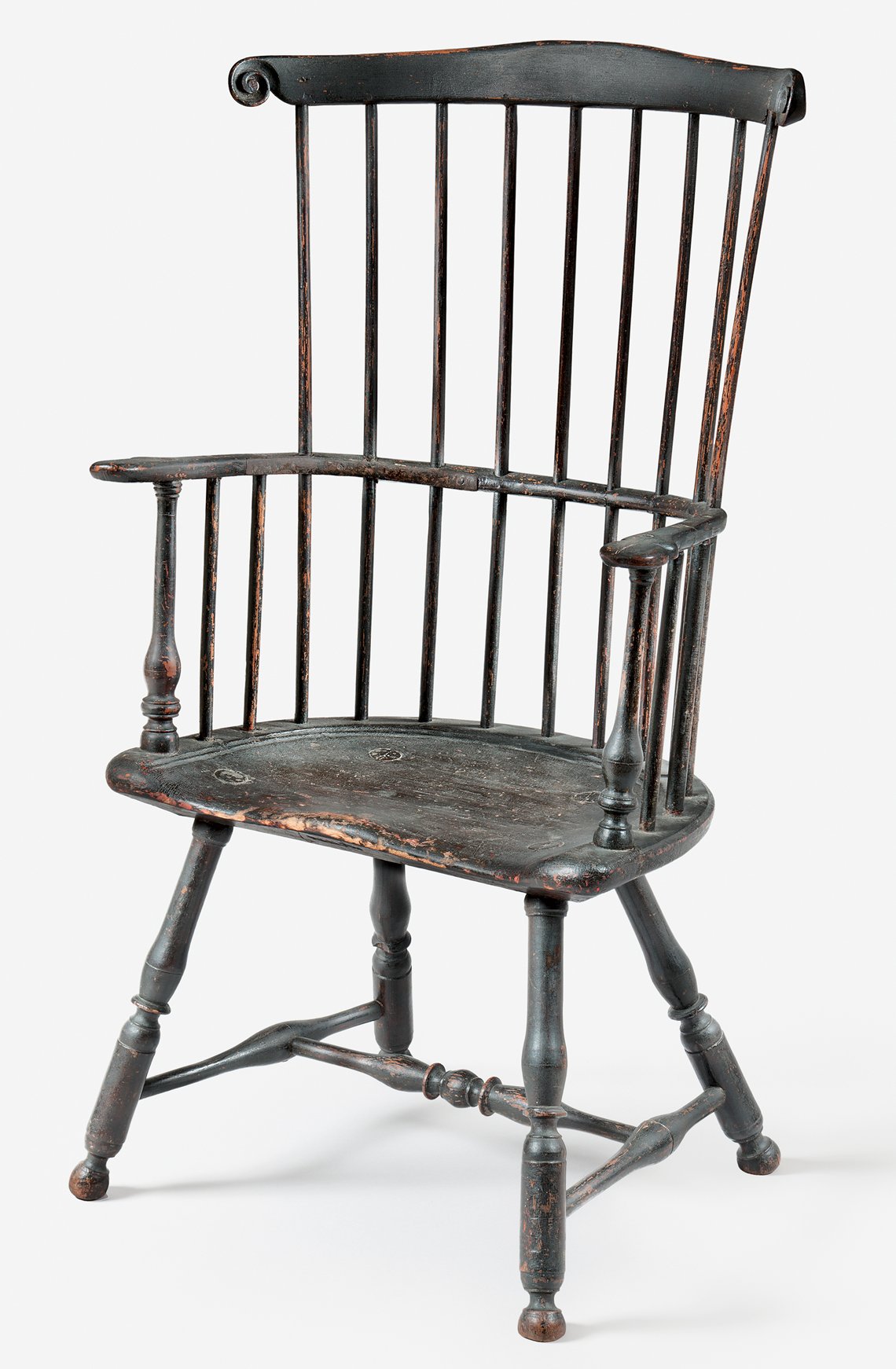 | |
Fig. 5: High-back Windsor armchair by Thomas Gilpin (active 1752-1767), Philadelphia, Penn., 1755–1760. Yellow poplar, hickory, oak, ash. H. 40¾, W. 22¾, D. 20½ in. Gilpin made high-back chairs in two sizes. This is the only smaller version known to survive. The height overall is more than four inches less than his full-size chairs and the seat is lower and narrower. Photo by Gavin Ashworth. |
Dietrich purchased the Lancaster County Windsor settee at auction from the estate of Stanley F. Todd of East Earl, Pennsylvania at Samuel T. Freeman’s & Co., Philadelphia (fig. 2). The acquisition of the settee reveals Dietrich’s inclination to trust his eye and intuition. Lancaster County settees are rare and were produced in much smaller numbers than Philadelphia settees. No finer Lancaster County settee and no other settees of this form have been published since the Todd sale.
The Gordons represented Dietrich in his last Windsor purchase of 1966, a New York City child’s continuous-bow Windsor armchair (fig. 3). The continuous-bow design was introduced by New York City chairmakers in the late 1780s or early 1790s.6 It was the first American Windsor design that had no European antecedents. Although not a product of southeastern Pennsylvania, the exceptional turnings, ornamented spindles, braced back, and brilliant proportional downsizing of an adult chair made it too captivating to pass up. While the chair may have been purchased as a placeholder in the event an equally remarkable child’s chair made in southeastern Pennsylvania became available, that opportunity never arose.
Only two Windsor forms collected between 1967 and 1984 remain in the Foundation, a pair of Lancaster fan-back side chairs purchased at Pennypacker Auction Center in Reading, Pennsylvania, in 1969 and a southeastern Pennsylvania Windsor stand purchased from a Massachusetts dealer in 1970 (Fig. 4). These early Windsor acquisitions reveal Dietrich’s practical approach to collecting that can also been seen in his strategy of collecting other forms of Americana—he sought to acquire superlative and documented examples produced during the eighteenth century. The table was a key addition to his growing collection of Windsors due its rarity and graceful form.
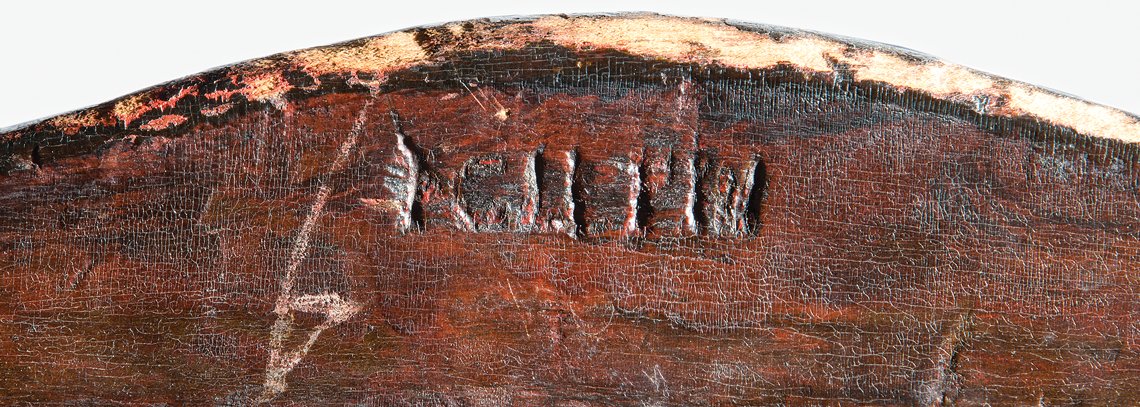 |
Fig 6: (Detail, fig. 5) T. GILPIN brand on seat pommel. Gilpin was the first American Windsor chairmaker to identify his work. Of perhaps a dozen Gilpin chairs that survive, the majority are stamped with his name brand. Photo by Gavin Ashworth. |
The release of Charles Santore’s The Windsor Style in America 7 and the loan exhibition, The Windsor: A Philadelphia Style, that Santore organized for the University Hospital Antiques Show in Philadelphia in April 1982, just months after his book was published, was instrumental in Dietrich’s renewed interest in his Windsor collection. In Santore (1935–2019), a specialist in American Windsors, Dietrich found a trusted advisor who would play an active role in his pursuit of exemplary examples. In 1985, Dietrich was able to add a rare early Philadelphia high-back Windsor armchair with the brand of Thomas Gilpin to his collection (Figs. 5, 6). Thomas Gilpin was one of the earliest Windsor chairmakers in America and may have been responsible for the introduction of carved volutes at the ends of the crest rail and the substitution of baluster-turned arm supports for the sawn slat supports of the earliest Philadelphia high-back chairs. In the following years other documented Windsors were added to the collection including a Philadelphia sack-back armchair by William Widdifield (active c. 1768–d. 1822) and a bow-back side chair by Gilbert Gaw (active 1793–1824). Another key addition in 1987 was a high-back Windsor armchair with a rail-less back and bracing spindles that extend from the crest to a tailpiece at the back of the seat (Fig. 7). Few examples of this late version of the Philadelphia high-back Windsor chair survive. To obtain this rare example of a Philadelphia Windsor form in superb condition it was purchased for what was at that time a record price for a Windsor chair at auction.
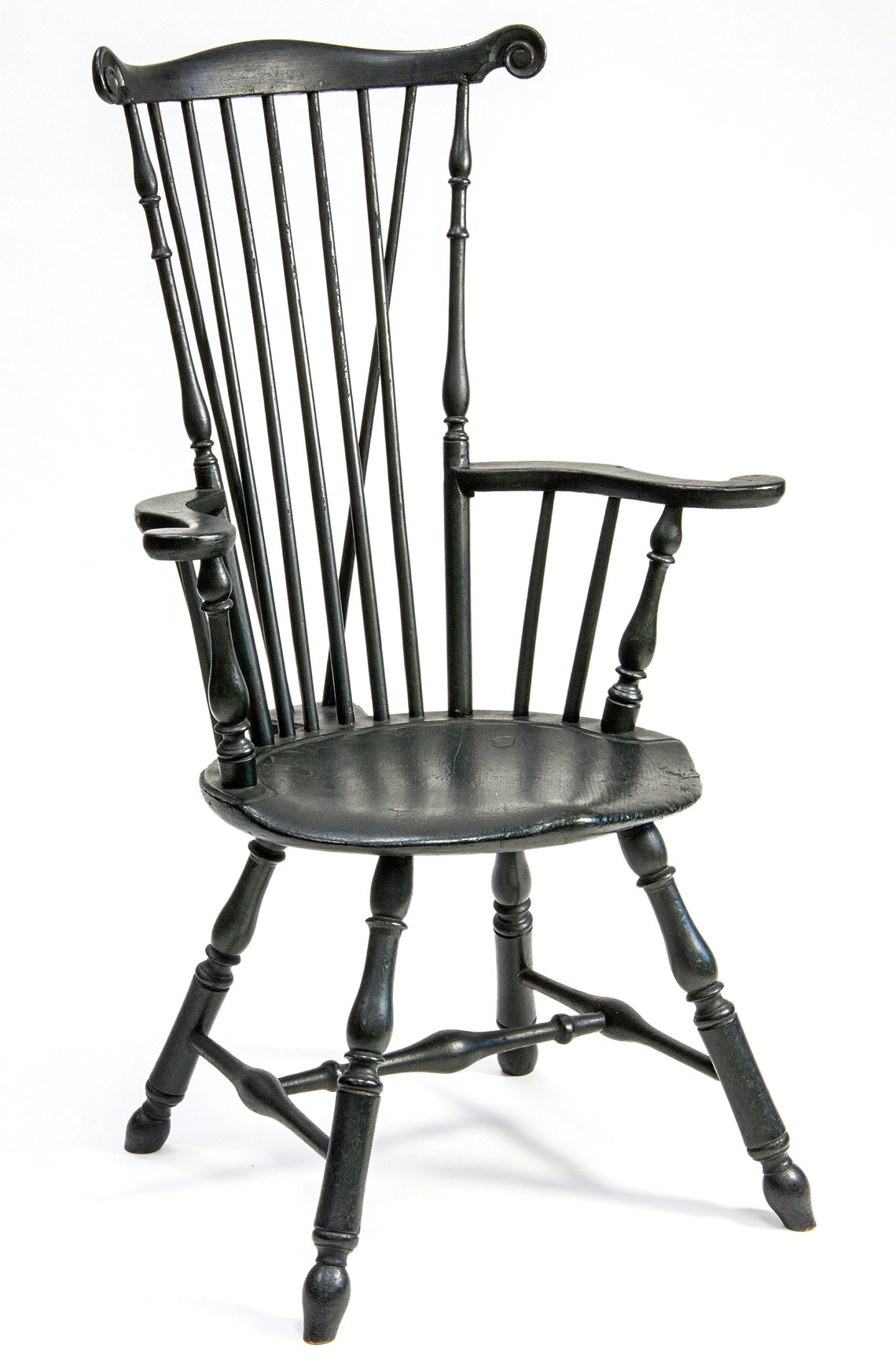 | 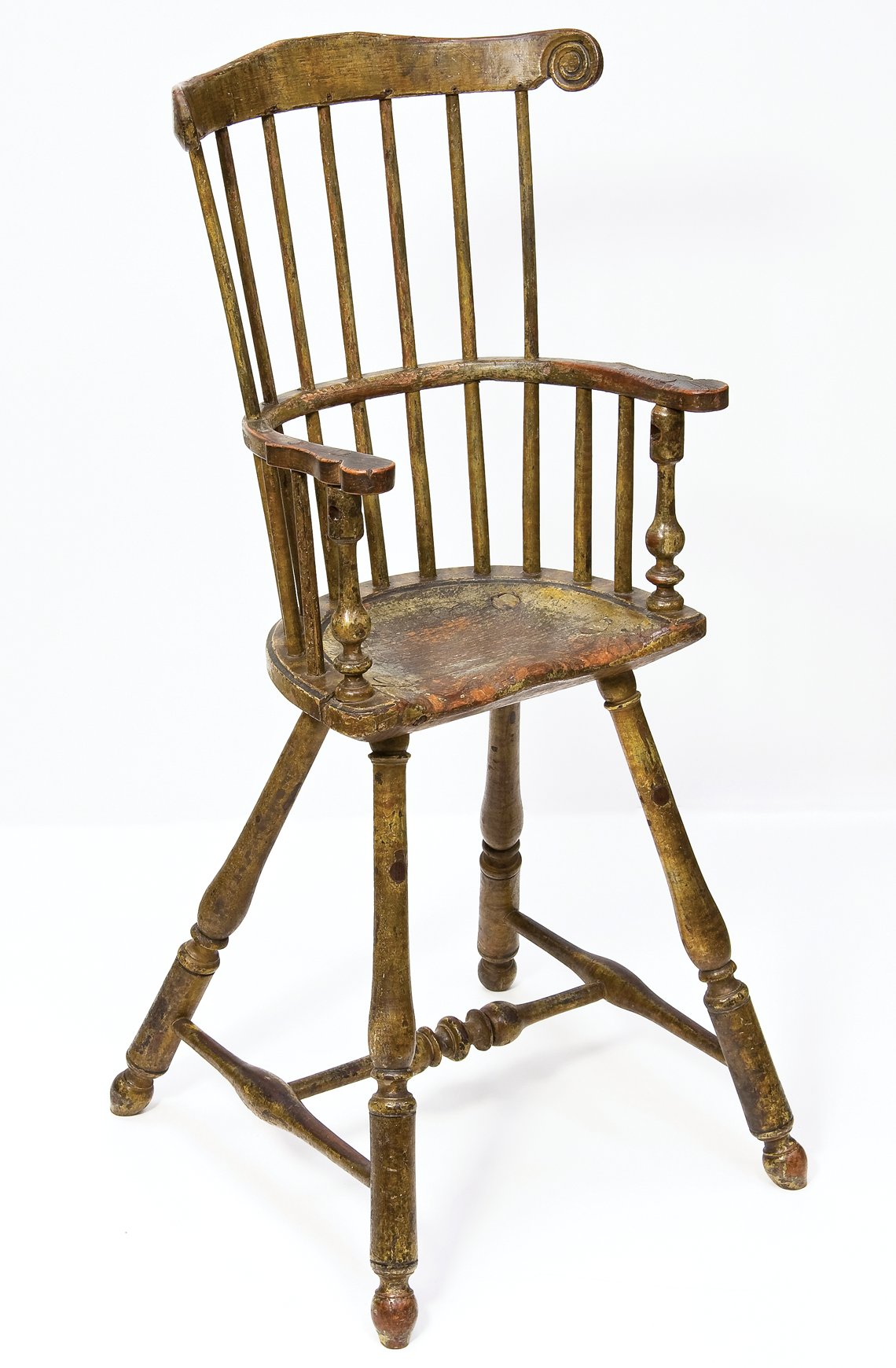 | |
Left, Fig 7: High-back Windsor armchair with bracing spindles, Philadelphia, 1765-1770. The arms are joined to the turned back posts in the manner of contemporary formal walnut and mahogany cabriole leg armchairs. The arms are attached with screws through the back of the post and the screw heads are covered with a wood plug. Photo by author. Right, Fig. 8: High-back Windsor highchair, Philadelphia, Penn., 1755–1765. Yellow poplar, maple, hickory, oak. H. 40, W. 18¾, D. 18¾ in. The first Windsor highchairs made in America were derived from Philadelphia high-back armchairs like that seen in fig. 7. Faux painted wood graining has been applied over the original green paint. Photo by author. | ||
With the purchase of a splendid Philadelphia high-back Windsor highchair (Fig. 8) at Sotheby’s sale of the collection of Catherine and Howard Feldman in 1988, Dietrich deemed his collection of American Windsors complete. Santore had illustrated the highchair in his first book on Windsors and included it in his University Hospital Antiques Show exhibition. The chair had been coveted as a consummate example of the art of Windsor chairmaking since the beginning of the twentieth century when it was owned and illustrated by Wallace Nutting.8 The maker skillfully handled the significant design challenge of reducing the size of an adult high-back chair—stretching the legs to raise the seat and diminishing the size of the back—while creating a chair with pleasing aesthetics and proportions.
With a small but noteworthy selection of Windsor forms now assembled, Dietrich began sharing his collection with the public. He did this in a novel way when he began to loan a large portion of his Windsor collection to the annual St. Peter’s in the Great Valley Antiques Show & Sale located near Arkadia. He did so four times between 1991 and 2001, writing an overview of Windsors and entries for one of the show catalogues himself. By doing this, Dietrich gave visitors to the show the chance to closely inspect masterful examples of the Windsor form in America while he continued to support and raise the profile of a beloved local institution.
 |
1. Nancy Goyne Evans, American Windsor Chairs (New York: Hudson Hills Press, 1996), 79–81. Philadelphia chairmakers began producing Windsor chairs about twenty years after they were first introduced in England.
2. Wallace Nutting, Furniture Treasury (Old America Company, 1928). Nutting illustrates over one-hundred and eighty American and English Windsors.
3. William Macpherson Hornor, Jr. Blue Book of Philadelphia Furniture (self published, Philadelphia, 1935).
4. J. Stogdell Stokes, “The American Windsor Chair,” The Pennsylvania Museum Bulletin (December 1925).
5. Charles Woolsey Lyon, advertisement, The Magazine Antiques, September 1963.
6. Nancy Goyne Evans, American Windsor Furniture, Specialized Forms (New York: Hudson Hills Press, 1997), 146.
7. Charles Santore, The Windsor Style in America (Philadelphia: Running Press, 1981).
8. Wallace Nutting, Furniture Treasury (Old America Company, 1928), fig. 2507.
 |
This article is the tenth in a series featuring the Dietrich American Foundation’s collection and is intended as a type of crowd sourcing exercise. Please share information with the author (contact details are below), which will be provided as learned. To learn more about the Dietrich American Foundation, visit dietrichamericanfoundation.org.
Christopher Storb is a furniture conservator, woodworking historian, and wood artist. Please send comments and related research to cstorb@gmail.com or call 610.212.5528.


















